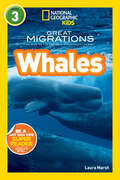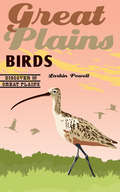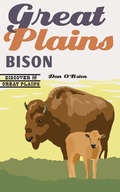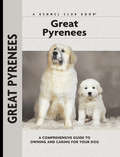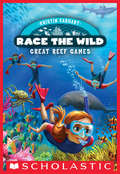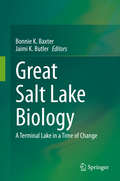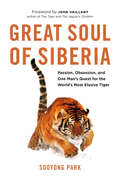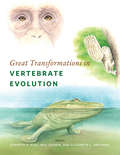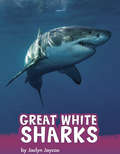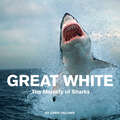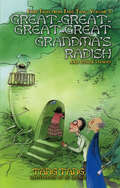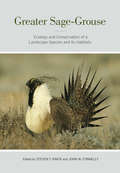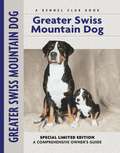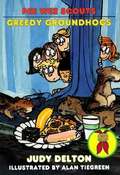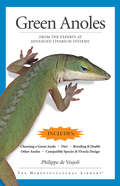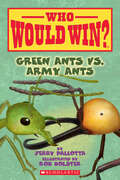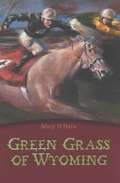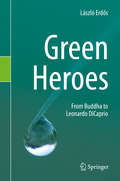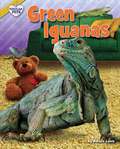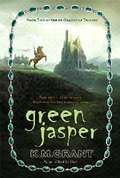- Table View
- List View
Great Migrations Elephants (Readers)
by Laura MarshThis exciting reader follows the story of the longest and the most demanding elephant migration on the planet. Living at the furthest corners of the hot and dry Sahara Desert, the very margins of where elephants can survive, hundreds of these great creatures make a dangerous but necessary journey as their main source of food and water dries up and they must go in search of more. Battling 120-degree heat, sandstorms, and fierce thunderstorms, these amazing animals travel 35 miles a day in a race against time in search of the bare essentials of life.National Geographic supports K-12 educators with ELA Common Core Resources.Visit www.natgeoed.org/commoncore for more information.
Great Migrations Whales (Readers)
by Laura MarshOver the course of their 70-year lifespan, sperm whales will easily travel the circumference of the Earth in search of food and the need to breed and find a mate. Males will travel as far north as the Bering Sea and as far south as Antarctica in order to find enough food to sustain their ways of live—up to 700 squid a day! Along the way, these massive beasts battle 30-feet-long giant squids, and each other, to sustain their ways of life.National Geographic supports K-12 educators with ELA Common Core Resources.Visit www.natgeoed.org/commoncore for more information.
Great Plains Birds (Discover the Great Plains)
by Larkin PowellThe Great Plains is a well-known and well-studied hybrid zone for many animals, most notably birds. In Great Plains Birds Larkin Powell explores the history, geography, and geology of the plains and the birds that inhabit it. From the sandhill crane to ducks and small shorebirds, he explains migration patterns and shows how human settlements have affected the movements of birds. Powell uses historical maps and images to show how wetlands have disappeared, how grasslands have been uprooted, how rivers have been modified by dams, and how the distribution of forests has changed, all the while illustrating why grassland birds are the most threatened group of birds in North America. Powell also discusses conservation attempts and how sporting organizations have raised money to create wetland and grassland habitats for both game and nongame species.Great Plains Birds tells the story of the birds of the plains, discussing where those birds can be found and the impact humans have had on them.
Great Plains Bison (Discover the Great Plains)
by Dan O'BrienGreat Plains Bison traces the history and ecology of this American symbol from the origins of the great herds that once dominated the prairie to its near extinction in the late nineteenth century and the subsequent efforts to restore the bison population. <p><p> A longtime wildlife biologist and one of the most powerful literary voices on the Great Plains, Dan O’Brien has managed his own ethically run buffalo ranch since 1997. Drawing on both extensive research and decades of personal experience, he details not only the natural history of the bison but also its prominent symbolism in Native American culture and its rise as an icon of the Great Plains. Great Plains Bison is a tribute to the bison’s essential place at the heart of the North American prairie and its ability to inspire naturalists and wildlife advocates in the fight to preserve American biodiversity.
Great Pyrenees
by Juliette CunliffeAs magnificent as the range whose name it bears, the Great Pyrenees (or Pyrenean Mountain Dog, as the breed is known in England) is a powerful, natural guard dog whose immense strength and quiet confidence elevate the breed beyond the realm of ordinary working dogs. The Great Pyrenees's attractive white coat and beautifully domed head impart an elegance to the breed that speaks to its unmistakable antiquity and purity. As the history chapter of this Comprehensive Owner's Guide discusses, the Great Pyrenees was originally bred as a livestock guardian in the Basque mountainous region between France and Spain, where it was called upon to protect flocks from wolves, bears, and other large predators. The modern-day development of the breed in Europe and its spread to England and the United States are covered in considerable detail. Owners considering adding a Pyr to their home and lives will profit from the chapter on breed characteristics which catalogs the breed's virtues as well as drawbacks. Considering the great size of the breed, its protective instincts, and its need of space, the awe-inspiring Great Pyrenees doesn't fit easily into every possible living situation. Of course, owners who do believe they can meet the challenges of Pyr ownership will be rewarded with a fearless, loyal, good-natured companion for life.New owners will welcome the well-prepared chapter on finding a reputable breeder and selecting a healthy, sound puppy. Chapters on puppy-proofing the home and yard, purchasing the right supplies for the puppy as well as house-training, feeding, and grooming are illustrated with photographs of handsome adults and puppies. In all, there are over 135 full-color photographs in this useful and reliable volume. The author's advice on obedience training will help the reader better mold and train into the most well-mannered dog in the neighborhood. The extensive and lavishly illustrated chapter on healthcare provides up-to-date detailed information on selecting a qualified veterinarian, vaccinations, preventing and dealing with parasites, infectious diseases, and more. Sidebars throughout the text offer helpful hints, covering topics as diverse as historical dogs, breeders, or kennels, toxic plants, first aid, crate training, carsickness, fussy eaters, and parasite control. Fully indexed.
Great Reef Games: Great Reef Games (Race the Wild #2)
by Kristin EarhartOn a once-in-a-lifetime race through the animal kingdom, it takes smarts, strength, and skill to win!Sage is used to being the fastest runner, the quickest climber, and the strongest swimmer around. And she's also used to taking charge. But when the second race course has the red team diving underwater to explore the Great Barrier Reef, it's trusting her teammates that matters most. It's sink or swim time....Each chapter in this action-packed adventure series is bursting with totally true facts about wild and wonderful creatures, dangerous habitats, maps, and more!
Great Rides of Today's Wild West: A Horseman's Photographic Journey Across the American West
by Mark BedorVeteran travel writer, photographer, and horseman Mark Bedor returns with another breathtaking adventure across the American West. This gorgeous photographic collection showcases twenty-six horseback rides across the United States (with one trip abroad to the great Australian Outback). For each, Bedor offers firsthand descriptions of the people and places, whether they’re tagging along on a cattle drive, taking part in a re-creation of Custer’s Last Stand, or just soaking in the natural vistas. Take part in the Great American Horse Drive in Colorado; ride through the spectacular Sierra Nevada at Inyo National Park; and step back in time to the Old West at Tombstone Monument Ranch. Whether the locations are working dude ranches, historic national parks, or world-famous travel destinations, Great Rides of Today’s Wild West shows them in full splendor through more than three hundred spectacular photographs by the author. The beauty, romance, and history of the Wild West and magnificent natural landscapes attract people from all over the world. This book lets you saddle up and ride across the country and beyond on some of the finest trails of today’s Wild West.
Great Salt Lake Biology: A Terminal Lake in a Time of Change
by Bonnie K. Baxter Jaimi K. ButlerGreat Salt Lake is an enormous terminal lake in the western United States. It is a highly productive ecosystem, which has global significance for millions of migrating birds who rely on this critical feeding station on their journey through the American west. For the human population in the adjacent metropolitan area, this body of water provides a significant economic resource as industries, such as brine shrimp harvesting and mineral extraction, generate jobs and income for the state of Utah. In addition, the lake provides the local population with ecosystem services, especially the creation of mountain snowpack that generates water supply, and the prevention of dust that may impair air quality. As a result of climate change and water diversions for consumptive uses, terminal lakes are shrinking worldwide, and this edited volume is written in this urgent context. This is the first book ever centered on Great Salt Lake biology. Current and novel data presented here paint a comprehensive picture, building on our past understanding and adding complexity. Together, the authors explore this saline lake from the microbial diversity to the invertebrates and the birds who eat them, along a dynamic salinity gradient with unique geochemistry. Some unusual perspectives are included, including the impact of tar seeps on the lake biology and why Great Salt Lake may help us search for life on Mars. Also, we consider the role of human perceptions and our effect on the biology of the lake. The editors made an effort to involve a diversity of experts on the Great Salt Lake system, but also to include unheard voices such as scientists at state agencies or non-profit advocacy organizations. This book is a timely discussion of a terminal lake that is significant, unique, and threatened.
Great Soul of Siberia
by John Vaillant Sooyong ParkIn The Great Soul of Siberia, renowned tiger researcher Sooyong Park tracks three generations of Siberian tigers living in remote southeastern Russia. Reminiscent of the way Timothy Treadwell (the so-called Grizzly Man) immersed himself in the lives of bears, Park sets up underground bunkers to observe the tigers, living thrillingly close to these beautiful but dangerous apex predators. At the same time, he draws from twenty years of experience and research to focus on the Siberian tigers' losing battle against poaching and diminishing habitat. Over the two years of his harrowing stakeout, Park's poignant and poetic observations of the tigers draw a fiercely compassionate portrait of these elusive, endangered creatures.
Great Transformations in Vertebrate Evolution
by Neil Shubin Kenneth P. Dial Elizabeth L. BrainerdHow did flying birds evolve from running dinosaurs, terrestrial trotting tetrapods evolve from swimming fish, and whales return to swim in the sea? These are some of the great transformations in the 500-million-year history of vertebrate life. And with the aid of new techniques and approaches across a range of fields--work spanning multiple levels of biological organization from DNA sequences to organs and the physiology and ecology of whole organisms--we are now beginning to unravel the confounding evolutionary mysteries contained in the structure, genes, and fossil record of every living species. This book gathers a diverse team of renowned scientists to capture the excitement of these new discoveries in a collection that is both accessible to students and an important contribution to the future of its field. Marshaling a range of disciplines--from paleobiology to phylogenetics, developmental biology, ecology, and evolutionary biology--the contributors attack particular transformations in the head and neck, trunk, appendages such as fins and limbs, and the whole body, as well as offer synthetic perspectives. Illustrated throughout, Great Transformations in Vertebrate Evolution not only reveals the true origins of whales with legs, fish with elbows, wrists, and necks, and feathered dinosaurs, but also the relevance to our lives today of these extraordinary narratives of change.
Great Transformations in Vertebrate Evolution
by Neil Shubin Elizabeth L. Brainerd Kenneth P. Dial, Neil Shubin, and Elizabeth L. BrainerdHow did flying birds evolve from running dinosaurs, terrestrial trotting tetrapods evolve from swimming fish, and whales return to swim in the sea? These are some of the great transformations in the 500-million-year history of vertebrate life. And with the aid of new techniques and approaches across a range of fields—work spanning multiple levels of biological organization from DNA sequences to organs and the physiology and ecology of whole organisms—we are now beginning to unravel the confounding evolutionary mysteries contained in the structure, genes, and fossil record of every living species. This book gathers a diverse team of renowned scientists to capture the excitement of these new discoveries in a collection that is both accessible to students and an important contribution to the future of its field. Marshaling a range of disciplines—from paleobiology to phylogenetics, developmental biology, ecology, and evolutionary biology—the contributors attack particular transformations in the head and neck, trunk, appendages such as fins and limbs, and the whole body, as well as offer synthetic perspectives. Illustrated throughout, Great Transformations in Vertebrate Evolution not only reveals the true origins of whales with legs, fish with elbows, wrists, and necks, and feathered dinosaurs, but also the relevance to our lives today of these extraordinary narratives of change.
Great White Sharks (Animal Predators Series)
by Sandra MarkleText and photographs describe the physical characteristics, keen senses, and hunting skills that make grizzly bears some of the best hunters in the world.
Great White Sharks (Animals)
by Jaclyn JaycoxGreat white sharks are the largest predatory sharks in the sea! They live all over the world, have many sharp teeth, and can smell blood from miles away. Dive deep into the ocean, and find all the facts about these incredible sharks.
Great White: The Majesty of Sharks
by Chris FallowsFor most people, sharks and fear go hand in hand. Renowned photographer and conservationist Chris Fallows maintains a more nuanced relationship with the super predator. Gasp-inducing in their immediacy and surprise, Fallows's brilliant photographs present these mighty creatures in a different light. Great White, the first publication to collect Fallows's work reveals the sublime beauty of sharks and provides a rare glimpse into the largely unseen world of great whites, hammerheads, and other breeds. Fallows captures these fearsome creatures both above water, as they intersect with humanity, and below, in their mysterious underwater domain. A one-of-a-kind portrait of the shark and a superlative study of the nature photographer's art, this collection is bound to turn heads and elicit a deep appreciation for the creatures that inhabit our oceans.
Great-Great-Great-Great Grandma's Radish: And Other Stories (Fairy Tales from Tang Tang)
by Tang TangWelcome to Fairy Tales from Tang Tang Tang Tang weaves traditional Chinese storytelling with Western fantasy elements, using vivid language to craft unique stories of wonder and magic. These beautiful, poignant fairy tales will leave an imprint on your heart with their universal themes of friendship, family, loyalty and loss. What happens when … a young boy is sent to rob a silly ghost? a young girl faces the Blue Hag feared by everyone in the village? a magical radish seed sets out to do great things? a primary school teacher reluctantly takes a class about fairy tales? This book is for children and for adults who never lost their sense of wonder. Translated from the original Chinese
Greater Sage-Grouse
by John W. Connelly Steven T. KnickAdmired for its elaborate breeding displays and treasured as a game bird, the Greater Sage-Grouse is a charismatic symbol of the broad open spaces in western North America. Unfortunately these birds have declined across much of their range--which stretches across 11 western states and reaches into Canada--mostly due to loss of critical sagebrush habitat. Today the Greater Sage-Grouse is at the center of a complex conservation challenge. This multifaceted volume, an important foundation for developing conservation strategies and actions, provides a comprehensive synthesis of scientific information on the biology and ecology of the Greater Sage-Grouse. Bringing together the experience of thirty-eight researchers, it describes the bird's population trends, its sagebrush habitat, and potential limitations to conservation, including the effects of rangeland fire, climate change, invasive plants, disease, and land uses such as energy development, grazing, and agriculture.
Greater Swiss Mountain Dog
by Nikki MoustakiThe Greater Swiss Mountain Dog descends from Switzerland's most ancient dogs and is the largest of the country's four Sennenhund breeds. Although a fairly new face in the US and England, the Swissy, as he's affectionately known, excels at cart-pulling, herding and guarding: he is prized as an "all-arounder," though draft work was his original occupation. Breeders today embrace the breed's tradition and involve their dogs in carting and weight-pulling events. The breed's black, tan and white tricolor markings, in fact the hallmark of all four Swiss mountain breeds, distinguish him as a handsome working dog of impressive height and musculature: he stands 27-28 inches at the shoulder. Like his homeland, the Swissy is industrious, versatile and easy to get along with, an ideal family dog who loves children and devotedly guards them. For an owner willing to give him the exercise, training and leg room he requires, the Swissy makes an exceptional choice. This new Special Limited Edition by well-known dog author Nikki Moustaki presents a complete introduction to the Greater Swiss Mountain Dog breed, including a look at the breed's long and romantic history and its present-day status, its characteristics and owner requirements and the breed standard. Chapters instructing new owners how to select, train and care for the puppy are comprehensive and well illustrated. Additionally, the book provides advice on feeding, grooming, house-training, obedience, showing and more. An up-to-date accurate chapter on healthcare for dogs, written by Dr. Lowell Ackerman, discusses everything a responsible owner needs to know about inoculations, parasites, spaying/neutering and much more.
Greedy Groundhogs (Pee Wee Scouts #22)
by Judy DeltonIf there's one thing Molly has learned about earning badges, it's that most of the time you have to try again and again before you get the hang of what you're trying to do. Well, she's used to trying hard for a badge, but this time she's trying over and over to get an unbadge. She's going to make an improvement to her house and get nothing at all for it. first she can't figure out what to make. Then what she makes is a big mess! As for the badge the scouts will really get, the one that is cute and furry, she has to see a groundhog. She can't find a groundhog anywhere and rats knees, it's cold out there where groundhogs dig their holes and make their big, underground homes! So while groundhogs are looking for their shadows to see how long winter will be, Molly is looking for them! She isn't the only one. All of the Pee Wees are having trouble. Some are even making it up that they saw a groundhog. When they decide to work together they show up in Cold winter wearing bathing suits. What's going on with these funny scouts now? The Pee Wees goof around, do good deeds, take on projects and have fun and adventures. Find out all about what scouts do in the many Pee Wee Scout books you can get from Bookshare including: #1 Cookies and Crutches, #2 Camp Ghost-Away, #3 Lucky Dog Days, #4 Blue Skies, French Fries, #5 Grumpy Pumpkins, #6 Peanut-Butter Pilgrims, #7 A Pee Wee Christmas, #8 That Mushy Stuff, #9 Spring Sprouts, #10 The Pooped Troop, #11 The Pee Wee Jubilee, #12 Bad, Bad, Bunnies, #13 Rosy Noses, Frozen Toes, #14 Sonny's Secret, #15 Sky Babies, #16 Trash Bash, #17 Pee Wees On Parade, #18 Lights, Action, Land-ho!, #19 Piles of Pets, #20 Fishy Wishes, #21 Pee Wees On skis, #23 All Dads on Deck, #24 Tricks and Treats, #25 Pee Wees on First, #26 Super Duper Pee Wees, #27 Teeny Weeny Zucchinis, #28 Eggs With Legs, #29 Pee Wee Pool Party, #30 Bookworm Buddies, #31 Moans and Groans and Dinosaur Bones, #32 Stage Frightened, and #33 Halloween Helpers. And there are even more pee Wee Scout books coming to Bookshare!
Greek and Roman Animal Sacrifice
by F. S. Naiden Christopher A. FaraoneThe interpretation of animal sacrifice, now considered the most important ancient Greek and Roman religious ritual, has long been dominated by the views of Walter Burkert, the late J.-P. Vernant, and Marcel Detienne. No penetrating and general critique of their views has appeared and, in particular, no critique of the application of these views to Roman religion. Nor has any critique dealt with the use of literary and visual sources by these writers. This book, a collection of essays by leading scholars, incorporates all these subjects and provides a theoretical background for the study of animal sacrifice in an ancient context.
Green Anoles
by Philippe De VosjoliA popular beginner's lizard, the green anole is the perfect introduction to the world of reptiles and continues to be popular among new herp lovers. These tiny, neat little lizards with the intense black eyes have suffered the fate of goldfish, as they've been marketed by pet shops as cheap, easy care, insect-eating reptiles. In order to keep green anoles thriving in their vivaria, pet owners must approach their husbandry with care and respect: Philippe de Vosjoli's Green Anoles provides the precise information necessary to reach that goal. The book begins with a chapter about the characteristics and behavior, natural history, and anatomy of green anoles, all of which is critical information for a keep to better understand the needs of his or her pet. As pets, green anoles are best kept in their vivaria and not handled, so the setup of a beautifully landscaped vivarium with proper lighting, heat, humidity, ventilation, and substrate is key. This Advanced Vivarium Systems title offers complete information about housing, feeding and nutrition, diseases and disorders, and breeding as well as how to set up naturalistic vivaria for one or more anoles or a community of anoles and compatible species. The chapter on other anoles recommends some very attractive species for the beginning lizard keeper to expand his anole family, such as the brown anole, big-headed anole, Cuban (or knight) anole, and Jamaican anole. The finale chapter on compatible species includes descriptions and photographs of a half dozen interesting options, such as the flying gecko, pigmy skink, and green tree frog. Resources and index included.
Green Ants vs. Army Ants (Who Would Win? #21)
by Jerry PallottaWhat if green ants and army ants had a fight? Who do you think would win? This nonfiction reader compares and contrasts two ferocious insects. Readers will learn about each animal's anatomy, behavior, and more. Then compare and contrast the battling pair before finally discovering the winner!This nonfiction series is full of facts, photos, and realistic illustrations, and it includes a range of mammals, sea creatures, insects, and dinosaurs to satisfy all kinds of animal fans.
Green Grass of Wyoming
by Mary O'HaraAs well as Ken's battle against the odds to achieve his dream, 'Green Grass of Wyoming' shows a boy's growth into maturity, taking his first steps in love. This classic story will be loved by children with the age group of 9+.
Green Heroes: From Buddha to Leonardo DiCaprio
by László ErdősThis book provides an introduction into the diversity of the environmental movement through great characters in the green sector. The book describes inspiring personal achievements, and at the same time it provides readers with information regarding the history, the main directions and the ethical principles of the environmental movement. Some of the most important characters of the movement from all around the world, are included in the book. As well as the title characters, Buddha and Leonardo DiCaprio, other famous environmentalists like Albert Schweitzer, David Attenborough and Jane Goodall are discussed. Some of the less well-known but equally important environmentalists such as Chico Mendes, Bruno Manser, Henry Spira, Tom Regan or Rossano Ercolini are highlighted in the various chapters. The selection of characters represents all major branches within the green sector, ranging from medieval saints to Hollywood celebrities, from university professors to field activists, from politicians to philosophers, from ecofeminists to radicals.
Green Iguanas (Peculiar Pets)
by Natalie LunisThinking about getting a new pet? How about a green iguana? These sun-loving creatures make the perfect pet--for the right kind of owner. Look inside to find out what these big green lizards eat as well as what kind of living space, training, and care they need. Along the way you'll also discover what all green iguana owners know--that the world of pets is a lot bigger than just cats and dogs.
Green Jasper (Book Two of the De Granville Trilogy)
by K. M. GrantIs it foolish to think that one boy and a blood red horse can save a fair maiden and the throne of England? Will and Gavin de Granville have come back from the crusade older, braver, and definitely wiser. Ellie has been longing for their return. But they've changed. And home is almost as dangerous as the war they've just left. The king is missing. The country is in turmoil. And some men would do anything for power. What will two brothers risk for the woman they both love and the king they have both sworn to protect and serve? In the second book of the de Granville trilogy, Will and Gavin find their family -- and all of England -- in serious peril.

